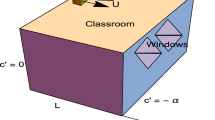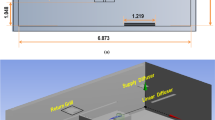Abstract
This study reviews the generation and diffusion characteristics of indoor viral aerosol particles, numerical simulation methods for the diffusion process of viral aerosols, and related research on the impact mechanism of different ventilation methods on the diffusion process of viral aerosols. Research has shown that the selection of initial conditions such as exhalation mode, initial airflow velocity, particle size, turbulence model, and calculation method for the generation of aerosol particles by the human body is of great significance for the numerical simulation of the diffusion process of viral aerosol particles. At the same time, on the basis of selecting appropriate ventilation methods, the reasonable setting of ventilation parameters (temperature, speed, height, etc.) can effectively suppress the spread of viral aerosols. This study can provide a theoretical basis for the study of related respiratory diseases, as well as technical and theoretical support for the selection of indoor ventilation methods to reduce the risk of human exposure caused by viral aerosols in the construction field. It also provides guidance and reference for aerosol transport and environmental protection in indoor atmospheric environments.










Similar content being viewed by others
Data availability
The data used during the study are available from the corresponding author by request.
References
Bhattacharyya S, Dey K, Paul AR, Biswas R (2020) A novel CFD analysis to minimize the spread of COVID-19 virus in hospital isolation room. Chaos Solitons Fractals 139:110294
Chen X, Liao B, Cheng L, Peng X, Xu X, Li Y, Hu T, Li J, Zhou X, Ren B (2020) The microbial coinfection in COVID-19. Appl Microbiol Biotechnol 104(18):7777–7785
Cho J, Kim J, Kim Y (2022) Development of a non-contact mobile screening center for infectious diseases: effects of ventilation improvement on aerosol transmission prevention. Sustain Cities Soc 87:104232
Deng W, Shen J, Tang X, Shen D (2005) The study on the optimization of indoor air distribution for SARS isolation wards. Build Energy Environ 24(2):9–14
Dong J (2018) Study on indoor pollutant particles motion simulation and the optimizing control of air-conditioning system. Shenyang Jianzhu University (Thesis)
Fang Z, Sun P, Ouyang Z, Liu P, Sun L, Wang X (2013) Study on the particle size and distribution characteristics of indoor air microorganisms in Beijing. Environ Sci 34(7):2526–2532
Ferry RM, Brown WF, Damon EB (1958) Studies of the loss of viability of stored bacterial aerosols. II. Death rates of several non-pathogenic organisms in relation to biological and structural characteristics. Epidemiol 56(1):125–150
Gao N, Niu J (2007) Modeling particle dispersion and deposition in indoor environments. Atmospheric Environ 41(18):3862–3876
Guo X (2020) Study on the evaporation and diffusion patterns of cough droplets under the influence of airflow organization and infection risk assessment. Huazhong Univ Sci Technol (Thesis)
Huttner BD, Catho G, Pano-Pardo JR, Pulcini C, Schouten J (2020) COVID-19: don’t neglect antimicrobial stewardship principles! Clin Microbiol Infect 26(7):808–810
Klepeis NE, Nelson WC, Ott WR, Robinson JP, Tsang AM, Switzer P, Behar JV, Hern SC, Engelmann WH (2001) The National Human Activity Pattern Survey (NHAPS): a resource for assessing exposure to environmental pollutants. J Expo Anal Environ Epidemiol 11(3):231–252
Li N, Rao D (2021) Simulation analysis of air distribution in a COVID-19 isolation ward in Kunming. Refrig Air Cond 35(4):542–546.551
Li X, Wang W, Kang N, Zhou L, Yu J (2022) Numerical study of aerosol propagation in open office spaces. Build Sci 38(02):209–216
Li WX, Hasama T, Chong A, Hang JG, Lasternas B, Lam KP, Tham KW (2023) Transient transmission of droplets and aerosols in a ventilation system with ceiling fans. Build Environ 230:109988
Liao Y (2017) Transmission and risk assessment of droplet pollutants in heating wards in high-altitude areas. Chongqing Univ (Thesis)
Liu S (2007) Study on the indoor transmission and movement patterns of microbial aerosols emitted from the oral cavity. Tianjin Univ (Thesis)
Liu P (2016) Characteristics of concentration changes and pollution control of airborne pollutants in wards. Chongqing Univ (Thesis)
Luan Y, Zhang L, Yin Y, Yan L, Wu X, Sun T (2022) Optimization of ventilation structure and virus spread patterns in large indoor places. Environ Eng 40(12):180–186
Mao N, Song M, Chan M, Pan D, Deng S (2016) Computational fluid dynamics (CFD) modelling of air flow field, mean age of air and CO2 distributions inside a bedroom with different heights of conditioned air supply outlet. Appl Energy 162:906–915
Mei D, Wang C, Li J, Xing F (2022) The impact and risk analysis of ventilation methods in box elevators on the spread of cough droplets. Chin J Infect Control 21(01):8–14
Ming Y (2013) Study of aerosol particulate pollutant of human body movement rule in air conditioning room. Shenyang Jianzhu Univ (Thesis)
Mirza S, Niwalkar A, Gupta A, Gautam S, Anshul A, Bherwani H, Biniwale R, Kumar R (2023) Is safe distance enough to prevent COVID-19? Dispersion and tracking of aerosols in various artificial ventilation conditions using OpenFOAM. Gondwana Res 114:40–54
Pei G, Taylor M, Rim D (2021) Human exposure to respiratory aerosols in a ventilated room: effects of ventilation condition, emission mode, and social distancing. Sustain Cities Soc 73(4):103090
Sun W (2007a) Transport of droplets expelled by coughing in ventilated rooms. Indoor Built Environ 16(6):493–504
Sun W (2007b) Research on the diffusion of polluted droplets in air conditioning rooms and the indoor thermal environment. Univ Sci Technol China (Thesis)
Tan B, Peng L, Long M, Feng Y, Zhu J, Pan Y (2022a) Numerical simulation and analysis and optimization of airflow in negative pressure wards based on CFD technology. Sci, Technol Eng 22(3):1117–1121
Tan F, Lin H, Li Z, Xie FJ, Yu RX, Liao Y (2022b) Simulation study on airflow organization and particle diffusion behavior in negative pressure isolation wards. Sci Technol Innov Appl 12(28):79–83
Tang S (2021) Simulation of air flow organization and energy consumption of air supply system in shelter hospitals in severe cold regions. Heilongjiang: Harbin Inst Technol (Thesis)
Vuorinen V, Aarnio M, Alava M, Alopaeus V, Atanasova N, Auvinen M, Balasubramanian N, Bordbar H, Erästö P, Grande R, Hayward N, Hellsten A, Hostikka S, Hokkanen J, Kaario O, Karvinen A, Kivistö I, Korhonen M, Kosonen R, Kuusela J, Lestinen S, Laurila E, Nieminen HJ, Peltonen P, Pokki J, Puisto A, Råback P, Salmenjoki H, Sironen T, Österberg M (2020) Modelling aerosol transport and virus exposure with numerical simulations in relation to SARS-CoV-2 transmission by inhalation indoors. Saf Sci 130:104866
Wan MP, Chao CYH, Ng YD, To GNS, Yu WC (2007) Dispersion of expiratory droplets in a general hospital ward with ceiling mixing type mechanical ventilation system. Aerosol Sci Technol 41(3):244–258
Wang X, Ren A, Wu Y, Wang B, Shi L (2020) Numerical simulation of viral droplet diffusion process based on Euler Lagrange method. Nat Mag 42(3):239–248
Wang F, Gao W, Li Q, Li J, Kong LY (2022a) Simulation and ventilation scheme optimization of viral particle diffusion in nucleic acid sampling rooms. Comput Aided Eng 31(1):5
Wang F, Niu G, Yang H, Xu X (2022b) Characteristics of aerosol diffusion in isolation wards under mixed and perforated ventilation. J Huazhong Univ Sci Technol (Nat Sci Ed) 50(10):18–25
Wells WF (1934) On air-borne infection. Study II. Droplets and droplet Nuclei. Am J Epidemiol 20(3):611–618
Wu X, Guo X, Xie J, Hou J, Duan M (2021) Numerical simulation of the effect of air supply on the propagation of cough droplets in isolation wards. Refrig Air Cond 35(03):305–311
Xie X, Li Y, Chwang ATY, Ho PL, Seto WH (2007) How far droplets can move in indoor environments revisiting the Wells evaporation-falling curve. Indoor Air, Copenhagen: Danish Tech Press 17(3):211–225
Yin Y, Li Y, Fu H, Luan Y (2021) Aerosol diffusion characteristics in indoor enclosed and ventilated spaces. Environ Eng 39(04):79–85
Yu Y, Gu Z, Liu SC, Zhao W (2014) Numerical study on the propagation and control of suspended biological particles in passenger cars. Sci Technol Eng 14(12):277–283
Yuan X, Chen Q, Glicksman LR, Hu Y, Yang X (1999) Measurements and computations of room airflow with displacement ventilation. ASHRAE Trans 105(1):340–352
Zeng K, Chen Y, Tan Y, Zhu Q (2022) The effect of wind speed on the diffusion of cough droplets in naturally ventilated classrooms. Build Therm Vent Air Cond 41(06):7–11
Zhang Y, Feng G, Bi Y, Cai Y, Zhang Z, Cao G (2019) Distribution of droplet aerosols generated by mouth coughing and nose breathing in an air-conditioned room. Sustain Cities Soc 51:101721
Zhang G, Hu C, Luo L, Fang F, Chen Y, Li J, Peng Z, Pan H (2020) Clinical features and short-term outcomes of 221 patients with COVID-19 in Wuhan. China J Clin Virol 127:104364
Zhang J, Feng D, Zuo Y (2023) Indoor microbial aerosol pollution and exposure assessment in public places in summer and autumn. Build Sci 39(02):251–260
Zhang Y (2019) A study on the mechanism of the effect of temperature stratification in displacement ventilation on the spread of droplets between people. Xi’an Univ Archit Technol (Thesis)
Zhao Y, Feng Y, Ma LD (2022) Impacts of human movement and ventilation mode on the indoor environment, droplet evaporation, and aerosol transmission risk at airport terminals. Build Environ 224:109527
Zheng L, Xu J, Wu F, Xu W, Long Z (2016) The effect of ventilation mode on the diffusion process of cough droplets among cabin personnel. China Shipbuild Res 11(02):12–20
Zhou Y, Ji S, Zhang D, Shi B, Tao W (2022) Numerical study on the risk of human infection caused by airborne particle transmission in consulting rooms. Archit Sci 38(02):217–222
Zhu Q (2022) Numerical simulation study on indoor aerosol propagation under different air supply methods. Donghua Univ (Thesis)
Funding
This work was supported by the National Natural Science Foundation of China [52006172], the Shaanxi Provincial Natural Science Basic Research Program [2024JC-YBMS-280], the National Funding Program for Postdoctoral Researchers [GZC20232228], and the Shaanxi Provincial Natural Science Basic Research Program-Youth Fund Project [2022JQ-506].
Author information
Authors and Affiliations
Contributions
Yaxin Huang: manuscript writing, data collation. Jie Wan: revise manuscript. Sen Han: manuscript writing, revise manuscript. Yu LI: manuscript writing, data collation.
Corresponding author
Ethics declarations
Ethical approval
Not applicable.
Consent to participate
All authors gave explicit consent to participate.
Consent for publication
All authors gave explicit consent to submit.
Conflict of interest
The authors declare no competing interests.
Additional information
Responsible Editor: Marcus Schulz
Publisher's Note
Springer Nature remains neutral with regard to jurisdictional claims in published maps and institutional affiliations.
Rights and permissions
Springer Nature or its licensor (e.g. a society or other partner) holds exclusive rights to this article under a publishing agreement with the author(s) or other rightsholder(s); author self-archiving of the accepted manuscript version of this article is solely governed by the terms of such publishing agreement and applicable law.
About this article
Cite this article
Huang, Y., Wan, J., Han, S. et al. Review of the research status on the transmission and diffusion characteristics of indoor viral aerosol particles. Environ Sci Pollut Res 31, 22308–22318 (2024). https://doi.org/10.1007/s11356-024-32239-8
Received:
Accepted:
Published:
Issue Date:
DOI: https://doi.org/10.1007/s11356-024-32239-8




